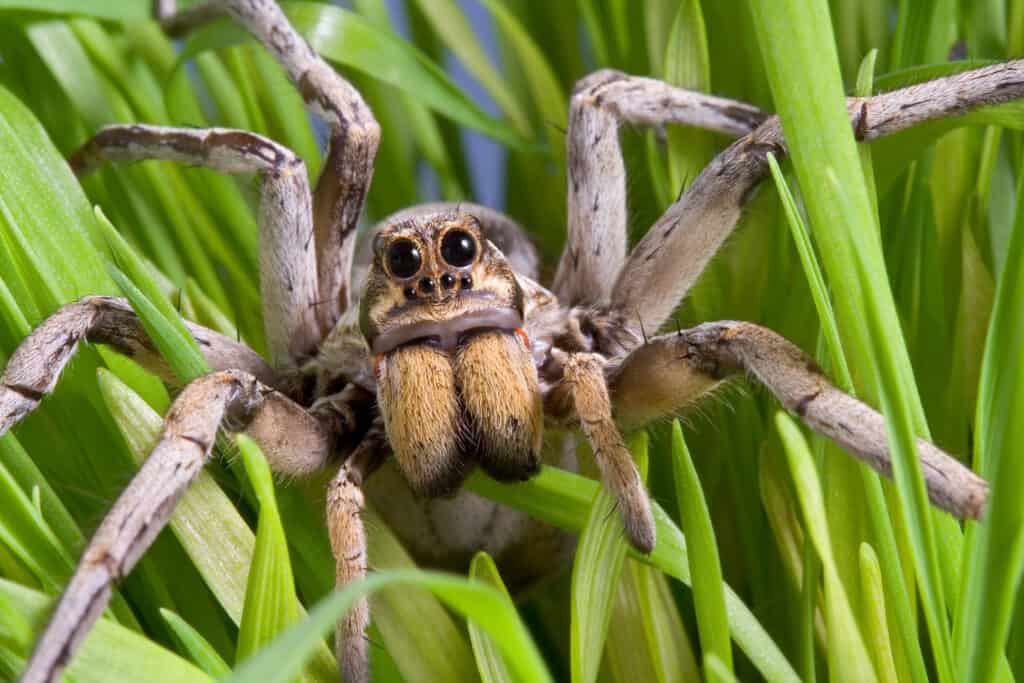It’s that time of year when the spiders come creeping out, invading gardens, homes, and backyards. Web building, food foraging, and sending off their young all mean that wolf spiders become more prevalent all season long.
If you don’t know how to identify them, wolf spiders could be of real concern, especially if you’re not a fan or allergic. But did you know that there are several types of these creepy crawlies, not just one species?
Below we’ll compare these arachnids with each other and some other items to help make them as identifiable as possible.
Wolf Spider Size

Thin-legged wolf spiders do not have medically significant venom, but their bite can be slightly painful and cause minor discomfort.
©Maksim Miasnikou/Shutterstock.com
While we often use the term “wolf spider” generically, there are actually more than 240 species in 21 genera of wolf spiders in North America alone.
Giving an average size for these arachnids, then, becomes a little challenging. However, generally speaking, the length of their bodies, no matter the species, generally falls between one-quarter inches and one and a half inches long.
Larger species of the spider may develop legs as long as three inches. This means they are pretty darn big spiders (about the size of the palm of your hand)! They are often mistaken for tarantulas because of it.
Wolf Spider Appearance and Behavior

Most wolf spiders do not make webs.
©Paul Reeves Photography/Shutterstock.com
The coloration for most wolf spiders is brown, though occasionally they will be such dark brown specimens that they’ll appear black. Because they’re active hunters, they may be seen either during the day or nighttime, depending on the species.
In many cases, many of the spiders will live in large colonies around homes, buildings, and other structures that have lush landscaping. They like to slip in under the doors and through cracks in the exterior so they can come in and make a warm nest and home.
If you see a spider carrying an egg sac on the tips of their abdomen, you’ve spotted a wolf spider. This is a unique trait that only these arachnids bear. If you see a spider that looks like its covered in small, awkward spots, it is also likely a wolf spider mother – their babies ride around on the back after hatching until they’re ready to move about on their own.
Are Wolf Spiders Dangerous?
Thankfully, unless you’re allergic to wolf spiders, these arachnids are more of a pest than anything else. Technically, all spiders are venomous, but not all are lethal. In the case of wolf spiders, their venom causes mild pain, swelling, or itchiness that doesn’t typically last for long.
If, however, you’re allergic to spiders or have a more severe reaction than mild stinging, itching, and swelling, head to a medical care facility immediately to ensure you’re properly taken care of.
Types of Wolf Spiders Comparison Chart

Wolf spiders are among the world’s most widely distributed spiders.
©iStock.com/CathyKeifer
More than 240 species of wolf spiders reside in North America, among 21 genera (or groups). The arachnids are regularly reclassified, however, so that number is likely to change. Sizes include body length only.
| Species/name | Size |
|---|---|
| Carolina wolf spider/Carolina spider (Hogna carolinensis) | 0.7 to 1.37 inches |
| Tigrosa grandis | 0.39 to 0.94 inches |
| Schizocosa mccooki | 0.4 to 0.89 inches |
| Forest wolf spiders (Hogna frondicola) | 0.35 to 0.55 inches |
| Geolycosa missouriensis | 0.59 to 0.82 inches |
| Rabid wolf spider (Rabidosa rabida) | 0.43 to 0.83 inches |
| Spotted wolf spider (Pardosa amentata) | 0.2 to 0.32 inches |
| Rabidosa punctulata | 0.43 to 0.67 inches |
| Allocosa subparva | 0.18 to 0.36 inches |
| Koch’s wolf spider (Alopecosa kochi) | Up to 1 inch |
Wolf Spiders Compared to Common Household Items
The median wolf spider is around half an inch, plus legs. The average wolf spider, with legs, is around the size of a watch face. The largest one is about the size of the inside palm of your hand.
The Largest Wolf Spider Ever Recorded
The record for largest wolf spider goes to the Giant Carolina Wolf Spider or Carolina spider. The big spider is often mistaken by folks for a small tarantula. These spiders have bodies about 1.5 inches on average, with legs an inch long. This makes them big enough to fill the palm of the average human hand. The big spider has been named the state spider for South Carolina.
Where Is the Wolf Spider Most Commonly Found?

Wolf spiders come in mostly brown to tan shades, usually with legs of different colors.
©iStock.com/Michele Jackson
With some 3,000 species of wolf spiders worldwide, the 250 species in the United States are widely scattered. They’re commonly found in urban and suburban areas. They love making their homes in gardens and lawns, tucked into corners in sheds, and all around the house. These places offer them easy prey.
Outside of city limits, you can pretty much find these spiders anywhere you go. They make their homes in coastal plains, inland habitats, coastal forest, shrublands, woodlands, and alpine meadows, to name a few of their favorites. Thankfully, since they make burrows instead of webs and aren’t particularly dangerous, you shouldn’t worry about them out in the woods.
The photo featured at the top of this post is © Cathy Keifer/Shutterstock.com
Thank you for reading! Have some feedback for us? Contact the AZ Animals editorial team.







